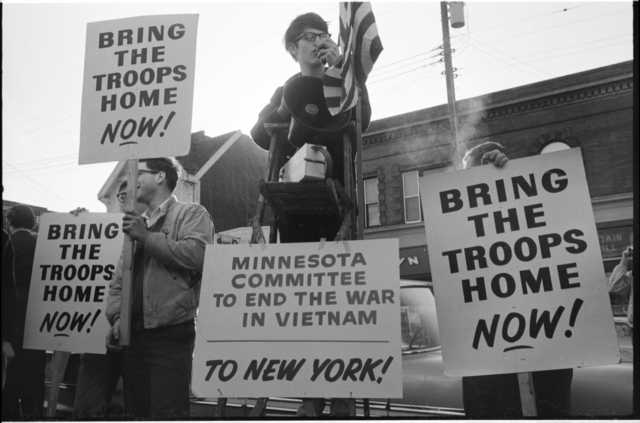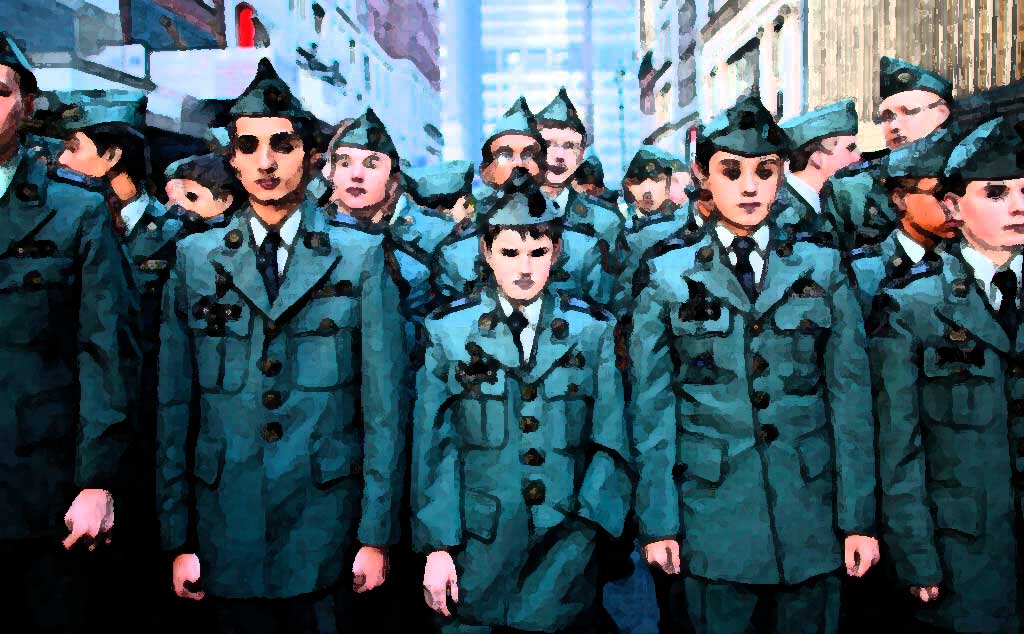 Jonah Walters, Jacobin - A smattering of information has been revealed about Connor Betts, the misogynist twenty-four-year-old who killed nine people and injured twenty-seven in Dayton earlier this month.
Jonah Walters, Jacobin - A smattering of information has been revealed about Connor Betts, the misogynist twenty-four-year-old who killed nine people and injured twenty-seven in Dayton earlier this month.
One of them was that he was in the Bellbrook High School Junior Reserve Officers’ Training Corps (JROTC) program, according to a classmate. We know little about Betts’s time in the program, the training he received, or what impact it had on him. But it’s worth mentioning that we have thousands of kids in America getting military training at school.
An estimated 500,000 high schoolers at 3,400 schools are enrolled in the JROTC, administered jointly by the military and each local school district. Students enrolled in JROTC classes are assigned ranks, taught military comportment and demeanor, and required to wear military uniforms. In most cases, students also receive training in military skills like marksmanship using school shooting ranges.
The Pentagon insists that JROTC is not a recruitment program, but a practical curriculum that teaches integrity and discipline — as innocuous as sports or physical education. But between 40 and 50 percent of students who complete three years of JROTC enlist in the military upon graduation, in part because JROTC graduates can receive enhanced pay and preferential benefits.
JROTC units are supervised by retired military officers who are exempt from civilian teaching certification requirements. To retain federal funding, each JROTC unit must maintain enrollment of 100 students or 10 percent of the student body — leaving the program vulnerable to organized student and parent boycotts.
The National Network Opposing the Militarization of Youth (NNOMY)
NNOMY
This article posting dedicated to Libby Frank of the Northwest Suburban Peace & Education Project
Emilio, Educarueca.org - In the summer of 1963, the League of War Resisters created a peace action committee that fundamentally fought against the anti-terrorism terrorism exercised by the US-backed Ngo Dinh Diem government of South Vietnam. On July 25 there were pickets in the house of the permanent observer from South Vietnam to the UN, and in October, a demonstration to “welcome” Mrs. Ngo Dinh Nhu during her visit to New York.
THE FIRST NATIONAL SCALE PROTEST.
The first important demonstration against the war took place in New York on December 19, 1964, and was supported by the WRL, CNVA, FOR, the socialist party and SPU. One thousand five hundred people took to the streets despite a temperature below zero to hear the war denounced to Muste, Norman Thomas and. Philip Randolph. In San Francisco, one hundred people heard Joan Baez sing. Other demonstrations took place in Minneapolis, Miami, Austin, Sacramento, Philadelphia, Chicago, Washington, Boston and Cleveland. A feature of the mobilization was the disclosure of "a Call to American Consciousness," which prompted an immediate ceasefire and the earliest possible withdrawal of US troops.
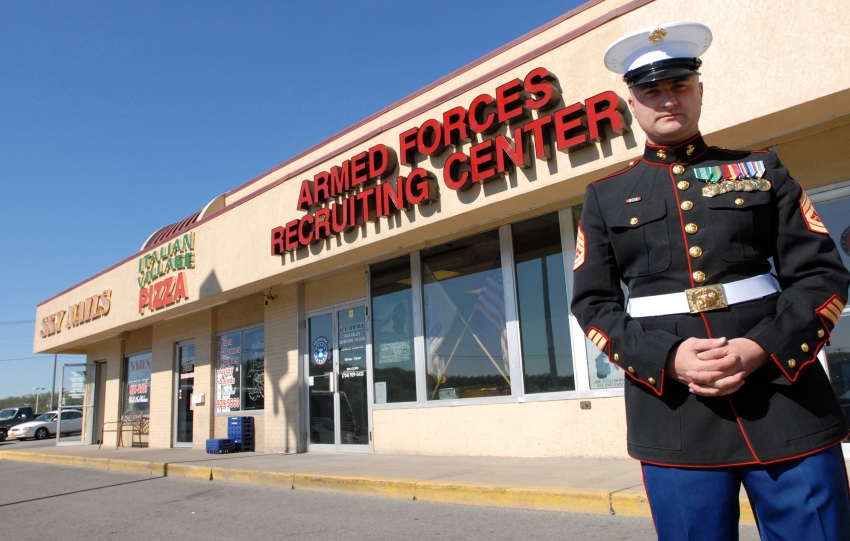 Elizabeth King, In These Times - Eighteen is the youngest age at which someone can join the U.S. military without their parents’ permission, yet the military markets itself to—which is to say recruits—children at much younger ages. This is in part accomplished by military recruiters who visit high schools around the country, recruiting children during career fairs and often setting up recruitment tables in cafeterias and hallways. As a result, most students in the U.S. will meet a military recruiter for the first time at just 17 years old, and children are getting exposed to military propaganda younger and younger.
Elizabeth King, In These Times - Eighteen is the youngest age at which someone can join the U.S. military without their parents’ permission, yet the military markets itself to—which is to say recruits—children at much younger ages. This is in part accomplished by military recruiters who visit high schools around the country, recruiting children during career fairs and often setting up recruitment tables in cafeterias and hallways. As a result, most students in the U.S. will meet a military recruiter for the first time at just 17 years old, and children are getting exposed to military propaganda younger and younger.
The recruitment of young people to the military is as old as the military itself, and has become more and more normalized along with the general militarization of schools. According to the Urban Institute, more than two-thirds of public high school students attend schools where there are “school resource officers,” a name for school-based police. This police presences comes on top of the role of military recruiters on campuses, or at college and career fairs.
Counter-recruitment surged in popularity during George W. Bush’s Iraq War, when the U.S. military ratcheted up recruitment for the war. But these days you don’t hear much about this movement, despite the fact that the U.S. is still engaged in brutal wars, from Yemen to Afghanistan, and the Trump administration has been threatening war with Iran. Out of the spotlight, dedicated counter-recruiters around the country are steadfast in their organizing to cut off the human supply chain to the U.S. military. U.S. wars have caused innumerable deaths, created long-term hardships in occupied nations, and cost trillions of dollars. Counter-recruitment, then, is about starving the military of the labor it needs to accomplish these destructive missions. When working with students, parents and school leadership, counter-recruiters focus on a variety of issues, including the negative personal consequences that come with being a soldier and broader problems like racism and U.S. imperialism.
 Elizabeth King, In These Times - Eighteen is the youngest age at which someone can join the U.S. military without their parents’ permission, yet the military markets itself to—which is to say recruits—children at much younger ages. This is in part accomplished by military recruiters who visit high schools around the country, recruiting children during career fairs and often setting up recruitment tables in cafeterias and hallways. As a result, most students in the U.S. will meet a military recruiter for the first time at just 17 years old, and children are getting exposed to military propaganda younger and younger.
Elizabeth King, In These Times - Eighteen is the youngest age at which someone can join the U.S. military without their parents’ permission, yet the military markets itself to—which is to say recruits—children at much younger ages. This is in part accomplished by military recruiters who visit high schools around the country, recruiting children during career fairs and often setting up recruitment tables in cafeterias and hallways. As a result, most students in the U.S. will meet a military recruiter for the first time at just 17 years old, and children are getting exposed to military propaganda younger and younger.
The recruitment of young people to the military is as old as the military itself, and has become more and more normalized along with the general militarization of schools. According to the Urban Institute, more than two-thirds of public high school students attend schools where there are “school resource officers,” a name for school-based police. This police presences comes on top of the role of military recruiters on campuses, or at college and career fairs.
Counter-recruitment surged in popularity during George W. Bush’s Iraq War, when the U.S. military ratcheted up recruitment for the war. But these days you don’t hear much about this movement, despite the fact that the U.S. is still engaged in brutal wars, from Yemen to Afghanistan, and the Trump administration has been threatening war with Iran. Out of the spotlight, dedicated counter-recruiters around the country are steadfast in their organizing to cut off the human supply chain to the U.S. military. U.S. wars have caused innumerable deaths, created long-term hardships in occupied nations, and cost trillions of dollars. Counter-recruitment, then, is about starving the military of the labor it needs to accomplish these destructive missions. When working with students, parents and school leadership, counter-recruiters focus on a variety of issues, including the negative personal consequences that come with being a soldier and broader problems like racism and U.S. imperialism.
Will Carless - Photographs by Sarah Blesener | Reveal
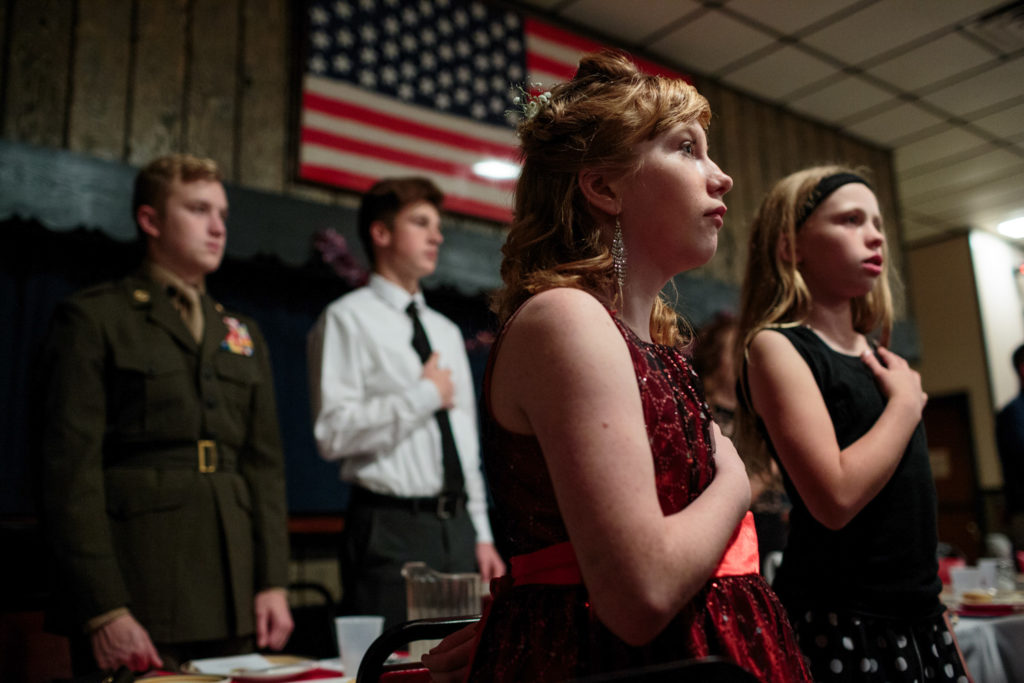
Students in the Young Marines program in Hanover, Pa., attend a ball at a Veterans of Foreign Wars hall in October 2017. They wear their finest dresses and suits. Their eyes fix on a large American flag as the national anthem falls from their lips.Credit: Sarah Blesener for Reveal
In rural central Florida, a group of children sit on a jetty, their reflections dappled in water the color of iced tea. It is quiet. Stifling, peaceful. The children pray over the breakfast they’re about to eat and ask for blessings for those whose hands prepared it. And they ask for safety during their upcoming weapons training, during which they will learn how to disarm a knife-wielding attacker, load a rifle and properly handle a handgun.
 The military has an enormous budget for recruiting and pressuring school districts that limit recruiter visits….Vigilance is necessary. During the school year 2017-18 Truth in Recruitment (TIR) leadership and staff met with Santa Barbara Unified School District (SBUSD) school board members Ismael Ulloa, Wendi Sims-Mooten and Jackie Reid as well as Assistant Superintendent Shawn Carey on four separate occasions. We discussed implementation of the Exhibit 5125.1 Recruiting Activities in the Santa Barbara Unified School District and the continued problem of policy violations.
The military has an enormous budget for recruiting and pressuring school districts that limit recruiter visits….Vigilance is necessary. During the school year 2017-18 Truth in Recruitment (TIR) leadership and staff met with Santa Barbara Unified School District (SBUSD) school board members Ismael Ulloa, Wendi Sims-Mooten and Jackie Reid as well as Assistant Superintendent Shawn Carey on four separate occasions. We discussed implementation of the Exhibit 5125.1 Recruiting Activities in the Santa Barbara Unified School District and the continued problem of policy violations.
Laura Jordan Jaffee -
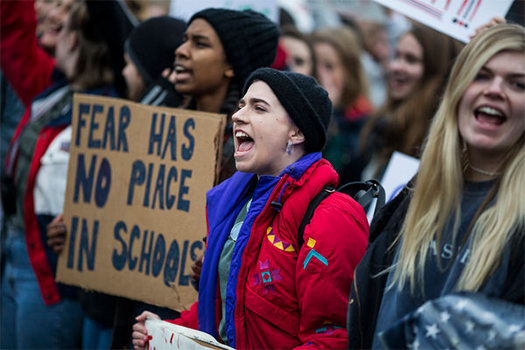 In June 2016, Congressional Democrats held a sit-in on the floor of the House of Representatives in an alleged effort to curb gun violence. While the move was largely commended by corporate media—even celebrated as a "civics lesson" for American schoolchildren in The Atlantic—,the legislation being fought for would have expanded the use of a notoriously inaccurate, racist and anti-Muslim "anti-terror" watchlist and done little to reduce violence (Richmond, 2016). This continues a long history of "gun control" policy in the U.S. that disproportionately incarcerates Black, Brown, and mentally disabled Americans by writing them as threats to safety and national security (Crenshaw, Ocen, & Nanda, 2015; Jilani, 2016; Coaston, 2016). 1 Responses to school shootings that uphold "gun control" as the panacea for reducing gun-related deaths subscribe to a liberal, non-violence framework that elides state violence and the structural conditions that engender individual acts of violence. 2
In June 2016, Congressional Democrats held a sit-in on the floor of the House of Representatives in an alleged effort to curb gun violence. While the move was largely commended by corporate media—even celebrated as a "civics lesson" for American schoolchildren in The Atlantic—,the legislation being fought for would have expanded the use of a notoriously inaccurate, racist and anti-Muslim "anti-terror" watchlist and done little to reduce violence (Richmond, 2016). This continues a long history of "gun control" policy in the U.S. that disproportionately incarcerates Black, Brown, and mentally disabled Americans by writing them as threats to safety and national security (Crenshaw, Ocen, & Nanda, 2015; Jilani, 2016; Coaston, 2016). 1 Responses to school shootings that uphold "gun control" as the panacea for reducing gun-related deaths subscribe to a liberal, non-violence framework that elides state violence and the structural conditions that engender individual acts of violence. 2
Calls for stricter gun control and mental health screening often come on the heels of school shootings, or they are justified by invoking national memories of these events. Such legislation is put forth as a necessary means of protecting the nation's (white) children through policies that criminalize people of color and psychiatrically disabled people, neglect state-sanctioned racist, gendered, and imperialist violence in schools, and reinforce ableist myths about who is "dangerous" (Crenshaw, Ocen, & Nanda, 2015). This paper asks how myopic conceptions of school safety circumscribe the imagined/imaginable solutions for fostering safe schools. I argue that a narrow notion of school safety derives from a narrow, ableist conception of school violence that pathologizes individuals who act violently and conceals state violence—particularly as it pertains to the production of empire—that manifests in schools. The very development and production of guns capable of such mass destruction—which liberal legislation seeks to restrict from the hands of Black, Brown, and disabled peoples—is a product of the endless war economy created by imperialist wars requisite for capital. 3
- The militarization of prayer in America: White and Native American spiritual warfare
- Soapbox Supports Demilitarization and the Prison (SLAVE) Labor Strike | Cindy Sheehan's Soapbox | NNOMY, Gary Ghirardi | Sept 03 2018
- The Pentagon Looks to Videogames for the Future of War
- Playing War: How the Military Uses Video Games
- Meet the Sims … and Shoot Them
- From "Gung-ho" to "Woke"
- The Missing Link in the Gun Debate
- First-person Shooter Games, the US Military, and Serial Killers
- Youth camps shape new generations with patriotism, pushups and prayer | Reveal News | Will Carless | March 9 2018
- Connecticut Peace Group Engages Students with a Peace Wheel
- NNOMY at the 2017 VFP Education Not Militarization Convention in Chicago
- Military Recruiting And How To Confront It
Subcategories
Opinion Article Count: 2
The NNOMY Opinion section is a new feature of our articles section. Writing on youth demilitarization issues is quite rare but we have discovered the beginning articles and notes being offered on this subject so we have decided to present them under an opinion category. The articles presented do not necessarily reflect the views of the NNOMY Steering Committee.
Globalization & Militarization Article Count: 1
Military Presence in Our Schools Article Count: 8
Art & Cultural Activism Article Count: 1
The Militarization of U.S. Culture Article Count: 23
 Though the United States of America shares with other nations in a history of modern state militarism, the past 65 years following its consolidation as a world military power after World War II, has seen a shift away from previous democratic characterizations of the state. The last thirty years, with the rise of the neo-conservative Reagan and Bush administrations (2), began the abandonment of moral justifications for democracy building replaced by bellicose proclamations of the need and right to move towards a national project of global security by preemptive military force .
Though the United States of America shares with other nations in a history of modern state militarism, the past 65 years following its consolidation as a world military power after World War II, has seen a shift away from previous democratic characterizations of the state. The last thirty years, with the rise of the neo-conservative Reagan and Bush administrations (2), began the abandonment of moral justifications for democracy building replaced by bellicose proclamations of the need and right to move towards a national project of global security by preemptive military force .
In the process of global military expansion, the US population has been subjected to an internal re-education to accept the role of the U.S. as consolidating its hegemonic rule internationally in the interest of liberal ideals of wealth creation and protectionism.
The average citizen has slowly come to terms with a stealthly increasing campaign of militarization domestically in media offerings; from television, movies and scripted news networks to reinforce the inevitability of a re-configured society as security state. The effect has begun a transformation of how, as citizens, we undertand our roles and viability as workers and families in relation to this security state. This new order has brought with it a shrinking public common and an increasing privatization of publicly held infrustructure; libraries, health clinics, schools and the expectation of diminished social benefits for the poor and middle-class. The national borders are being militarized as are our domestic police forces in the name of Homeland Security but largely in the interest of business. The rate and expansion of research and development for security industries and the government agencies that fund them, now represent the major growth sector of the U.S.economy. Additionally, as the U.S. economy continually shifts from productive capital to financial capital as the engine of growth for wealth creation and development, the corporate culture has seen its fortunes rise politically and its power over the public sector grow relatively unchallenged by a confused citizenry who are watching their social security and jobs diminishing.
How increasing cultural militarization effects our common future will likely manifest in increased public dissatisfaction with political leadership and economic strictures. Social movements within the peace community, like NNOMY, will need to expand their role of addressing the dangers of militarists predating youth for military recruitment in school to giving more visibility to the additional dangers of the role of an influential militarized media, violent entertainment and play offerings effecting our youth in formation and a general increase and influence of the military complex in all aspects of our lives. We are confronted with a demand for a greater awareness of the inter-relationships of militarism in the entire landscape of domestic U.S. society. Where once we could ignore the impacts of U.S. military adventurisms abroad, we are now faced with the transformation of our domestic comfort zone with the impacts of militarism in our day to day lives.
How this warning can be imparted in a meaningful way by a movement seeking to continue with the stated goals of counter-recruitment and public policy activism, and not loose itself in the process, will be the test for those activists, past and future, who take up the call to protect our youth from the cultural violence of militarism.
The "militarization of US culture" category will be an archive of editorials and articles about the increasing dangers we face as a people from those who are invested in the business of war. This page will serve as a resource for the NNOMY community of activists and the movement they represent moving into the future. The arguments presented in this archive will offer important realizations for those who are receptive to NNOMY's message of protecting our youth, and thus our entire society, of the abuses militarism plays upon our hopes for a sustainable and truly democratic society.
NNOMY
Resources Article Count: 2
The Resources section covers the following topics:
International Networking Article Count: 1
Book Reviews Article Count: 5
NNOMY Network News Article Count: 12
News reports from the groups associated to the NNOMY Network including Social Media.
CR Reports Article Count: 5
Reports from counter-recruitment groups and activists from the field. Includes information about action reports at recruiting centers and career fairs, school tabling, and actions in relation to school boards and state legislatures.
CR in the News Article Count: 8
David Swanson Article Count: 6
 David Swanson is the author of the new book, Daybreak: Undoing the Imperial Presidency and Forming a More Perfect Union, by Seven Stories Press and of the introduction to The 35 Articles of Impeachment and the Case for Prosecuting George W. Bush by Dennis Kucinich. In addition to cofounding AfterDowningStreet.org, he is the Washington director of Democrats.com and sits on the boards of a number of progressive organizations in Washington, DC.
David Swanson is the author of the new book, Daybreak: Undoing the Imperial Presidency and Forming a More Perfect Union, by Seven Stories Press and of the introduction to The 35 Articles of Impeachment and the Case for Prosecuting George W. Bush by Dennis Kucinich. In addition to cofounding AfterDowningStreet.org, he is the Washington director of Democrats.com and sits on the boards of a number of progressive organizations in Washington, DC.
Charlottesville Right Now: 11-10-11 David Swanson
David Swanson joins Coy to discuss Occupy Charlottesville, protesting Dick Cheney's visit to the University of Virginia, and his new book. - Listen
Jorge Mariscal Article Count: 2
 Jorge Mariscal is the grandson of Mexican immigrants and the son of a U.S. Marine who fought in World War II. He served in the U.S. Army in Vietnam and currently teaches at the University of California, San Diego.
Jorge Mariscal is the grandson of Mexican immigrants and the son of a U.S. Marine who fought in World War II. He served in the U.S. Army in Vietnam and currently teaches at the University of California, San Diego.
Matt Guynn Article Count: 1
 Matt Guynn plays the dual role of program director and coordinator for congregational organizing for On Earth Peace, building peace and nonviolence leadership within the 1000+ congregations of the Church of the Brethren across the United States and Puerto Rico. He previously served a co-coordinator of training for Christian Peacemaker Teams, serving as an unarmed accompanier with political refugees in Chiapas, Mexico, and offering or supporting trainings in the US and Mexico.
Matt Guynn plays the dual role of program director and coordinator for congregational organizing for On Earth Peace, building peace and nonviolence leadership within the 1000+ congregations of the Church of the Brethren across the United States and Puerto Rico. He previously served a co-coordinator of training for Christian Peacemaker Teams, serving as an unarmed accompanier with political refugees in Chiapas, Mexico, and offering or supporting trainings in the US and Mexico.
Rick Jahnkow Article Count: 8
 Rick Jahnkow works for two San Diego-based anti-militarist organizations, the Project on Youth and Non-Military Opportunities and the Committee Opposed to Militarism and the Draft. He can be reached at: This email address is being protected from spambots. You need JavaScript enabled to view it.
Rick Jahnkow works for two San Diego-based anti-militarist organizations, the Project on Youth and Non-Military Opportunities and the Committee Opposed to Militarism and the Draft. He can be reached at: This email address is being protected from spambots. You need JavaScript enabled to view it.
Pat Elder Article Count: 12
 Pat Elder was a co-founder of the DC Antiwar Network (DAWN) and a member of the Steering Committee of the National Network Opposing the Militarization of Youth, (NNOMY). Pat is currently involved in a national campaign with the Women's International League for Peace & Freedom project, Military Poisons, investigating on U.S. military base contamination domestically and internationally. Pat’s work has prominently appeared in NSA documents tracking domestic peace groups.
Pat Elder was a co-founder of the DC Antiwar Network (DAWN) and a member of the Steering Committee of the National Network Opposing the Militarization of Youth, (NNOMY). Pat is currently involved in a national campaign with the Women's International League for Peace & Freedom project, Military Poisons, investigating on U.S. military base contamination domestically and internationally. Pat’s work has prominently appeared in NSA documents tracking domestic peace groups.
All Documents:
Pat Elder - National Network Opposing the Militarization of Youth
COMMUNITY ACTION Article Count: 2
Network Actions Article Count: 5
EVENTS & CONFERENCES Article Count: 4
NNOMY periodically participates in or organizes events(e.i. conferences, rallies) with other organizations.
CR Activist Reports Article Count: 2
CR Discussion List Article Count: 1
NNOMY in the News Article Count: 13
National CR Database Article Count: 1
GI Resistance Article Count: 1
Conscientious Objection Article Count: 1
NNOMY National Conference Article Count: 11
Materials/Training Article Count: 1
For Educators/Guidance Counselors Article Count: 2
Recruiting on College Campuses Article Count: 1
Model Programs Article Count: 1
School Policies Article Count: 5
EN ESPAÑOL Article Count: 1
Equal access Article Count: 1
NCLB Article Count: 1
MILITARISM & WAR Article Count: 3
FOR ENLISTED PERSONNEL Article Count: 1
FOR PARENTS Article Count: 1
CONSIDERING ENLISTING? Article Count: 1
RECRUITING IN SPECIFIC COMMUNITIES Article Count: 1
MILITARY RECRUITING TOOLS & METHODS Article Count: 3
SCHOOL BASED COUNTER RECRUITMENT Article Count: 6
Know Your Rights Article Count: 2
Delayed Entry Program/DEP Article Count: 1
Alternatives by State Article Count: 1
NNOMY Article Count: 13
ALTERNATIVES TO THE MILITARY Article Count: 3
Facts & Figures Article Count: 1
COUNTER RECRUITING ESSENTIALS Article Count: 1
The Counter-recruitment Essentials section of the NNOMY web site covers the issues and actions spanning this type of activism. Bridging the difficult chasms between religious, veteran, educator, student, and community based activism is no small task. In this section you will find information on how to engage in CR activism in your school and community with the support of the knowledge of others who have been working to inform youth considering enlisting in the military. You will also find resources for those already in the military that are looking for some guidance on how to actively resist injustices as a soldier or how to choose a path as a conscientious objector.
Steering Committee Article Count: 1
Articles Article Count: 227
John Judge Article Count: 5
![]() John Judge was a co-founder of the Committee for High School Options and Information on Careers, Education and Self-Improvement (CHOICES) in Washington DC, an organization engaged since 1985 in countering military recruitment in DC area high schools and educating young people about their options with regard to the military. Beginning with the war in Viet Nam, Judge was a life-long anti-war activist and tireless supporter of active-duty soldiers and veterans.
John Judge was a co-founder of the Committee for High School Options and Information on Careers, Education and Self-Improvement (CHOICES) in Washington DC, an organization engaged since 1985 in countering military recruitment in DC area high schools and educating young people about their options with regard to the military. Beginning with the war in Viet Nam, Judge was a life-long anti-war activist and tireless supporter of active-duty soldiers and veterans.
"It is our view that military enlistment puts youth, especially African American youth, at special risk, not only for combat duty, injury and fatality, but for military discipline and less than honorable discharge, which can ruin their chances for employment once they get out. There are other options available to them."
In the 1970's the Selective Service System and the paper draft became unworkable, requiring four induction orders to get one report. Boards were under siege by anti-war and anti-draft forces, resistance of many kinds was rampant. The lottery system failed to dampen the dissent, since people who knew they were going to be drafted ahead of time became all the more active. Local draft board members quit in such numbers that even I was approached, as a knowledgeable draft counselor to join the board. I refused on the grounds that I could never vote anyone 1-A or eligible to go since I opposed conscription and the war.
At this point the Pentagon decided to replace the paper draft with a poverty draft, based on economic incentive and coercion. It has been working since then to draw in between 200-400,000 enlisted members annually. Soon after, they began to recruit larger numbers of women to "do the jobs men don't want to". Currently recruitment quotas are falling short, especially in Black communities, and reluctant parents are seen as part of the problem. The hidden problem is retention, since the military would have quadrupled by this time at that rate of enlistment, but the percentage who never finish their first time of enlistment drop out at a staggering rate.
I began bringing veterans of the Vietnam War into high schools in Dayton, Ohio in the late 1960s, and have continued since then to expose young people to the realities of military life, the recruiters' false claims and the risks in combat or out. I did it first through Vietnam Veterans Against the War/Winter Soldier Organization, then Dayton Draft & Military Counseling, and since 1985 in DC through C.H.O.I.C.E.S.
The key is to address the broader issues of militarization of the schools and privacy rights for students in community forums and at meetings of the school board and city council. Good counter-recruitment also provides alternatives in the civilian sector to help the poor and people of color, who are the first targets of the poverty draft, to find ways to break into the job market, go to a trade school, join an apprenticeship program, get job skills and placement help, and find money for college without enlisting in the military.
- War Opponents Train For Visits to Area Schools And Recruitment Centers, Michelle Boorstein, Washington Post
- Counter-Recruitment and the Campaign to Demilitarize Public Schools - Scott Harding, Seth Kershner
- C.H.O.I.C.E.S., John Judge
- Interview - John Judge - U.S. Wars & Military Recruitment
- Military and your Schools
- A Celebration of the Life of John Judge May 31, 2014
- In Memory of John Judge - Washington Peace Center
- John Judge- Obituary and request for reflections - Coalition on Political Assassinations (COPA)
- The Loss of John Judge Hits Hard - David Swanson
- John Judge, Leading Change: A Transformational, Quiet Servant Leader, David Ratcliffe
###

